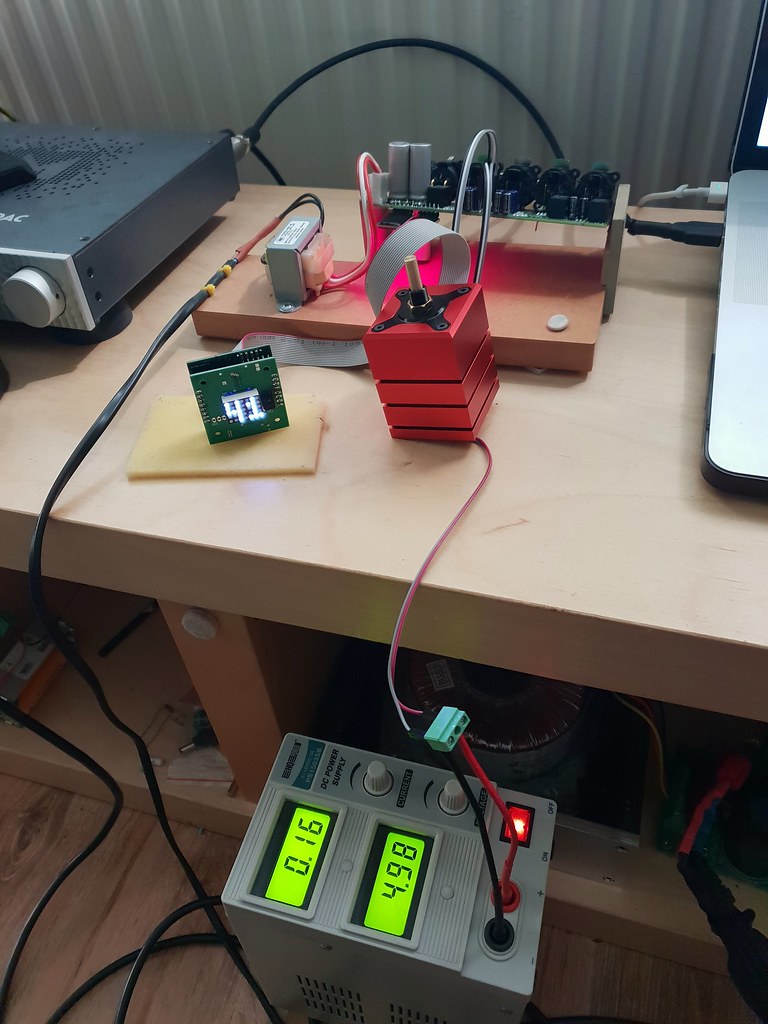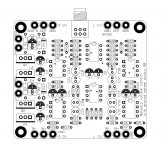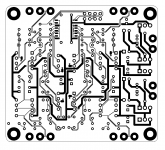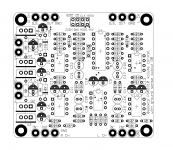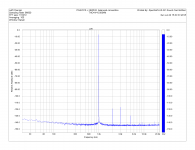Arrived works fine, up and running in 5 minutes, Super good matching across channels. Plenty of range on the attenuation.
Just curious - did you make any modifications to prevent the "infinity gain" issue (referenced here)?
Nat, yup, 1db steps over 63 db range. I'll never use the last 20 with my dad, I might get knocking on the door of the last ten with my paradise.
Maartn, I made no mods. I can't ever imagine mistakenly hitting it up to 0db attenuation. All power off, out of mute routines return to previous output level. I'll have to check what happens if I power the attenuator off by mistake with the preamp left on, that might be a bad thing. Hopefully the relays retain the current volume level when depowered.
I'll have to run some tests when I ready to dismantle it for final assembly.
Maartn, I made no mods. I can't ever imagine mistakenly hitting it up to 0db attenuation. All power off, out of mute routines return to previous output level. I'll have to check what happens if I power the attenuator off by mistake with the preamp left on, that might be a bad thing. Hopefully the relays retain the current volume level when depowered.
I'll have to run some tests when I ready to dismantle it for final assembly.
Does the Khozmo have a position that will take it to infinity gain?
I've forgotten much of the linear pot theory bit (even reading Hans' post about it doesn't bring back the murky understanding I was begining to visualise) and even if it's relevent when using a resistor ladder, but couldn't a fixed resistor divider be installed in place of the suggested second pot (the Z in Hans' post) to optimise the range?
I've forgotten much of the linear pot theory bit (even reading Hans' post about it doesn't bring back the murky understanding I was begining to visualise) and even if it's relevent when using a resistor ladder, but couldn't a fixed resistor divider be installed in place of the suggested second pot (the Z in Hans' post) to optimise the range?
BPBP in through hole, pot or digital
Apologies for looking in a slightly different direction - I hope this may be of interest.
After building no less than three BPBPs - thank you Bruno Putzeys and Jan Didden for the article and the PCBs - I re-implemented BPBP with through hole components and a couple of minor twists. I built versions controlled by a normal mechanical pot, a WM8816 and a PGA2310. Details are here.
Apologies for looking in a slightly different direction - I hope this may be of interest.
After building no less than three BPBPs - thank you Bruno Putzeys and Jan Didden for the article and the PCBs - I re-implemented BPBP with through hole components and a couple of minor twists. I built versions controlled by a normal mechanical pot, a WM8816 and a PGA2310. Details are here.
Attachments
Last edited:
Thank you!
I only had a chance to listen to the mechanical pot version so far, with a Vishay Sfernice P9 pot, followed by a stereo LM3886 in a test setup - sounds very nice indeed. Still need to listen to the other two options, perhaps with a different power amp that I am more familiar with.
I only had a chance to listen to the mechanical pot version so far, with a Vishay Sfernice P9 pot, followed by a stereo LM3886 in a test setup - sounds very nice indeed. Still need to listen to the other two options, perhaps with a different power amp that I am more familiar with.
The beauty of Putzeys design is not exactly the circuit diagram that is also used by Mark Levinson and others, but in the very smart design of the PCB, thereby avoiding ground loops, crosstalk and CMRR.Thank you!
I only had a chance to listen to the mechanical pot version so far, with a Vishay Sfernice P9 pot, followed by a stereo LM3886 in a test setup - sounds very nice indeed. Still need to listen to the other two options, perhaps with a different power amp that I am more familiar with.
So out of interest to compare, could you give it a try to measure CMRR vs frequency with your through hole PCB in a few different volume settings ?
Regards, Hans
I agree - the whole point of this exercise for me is not to try yet another schematic but to learn how to make low distortion PCBs. Mr. Putzeys' method works here and also for gainclones/chipamps.The beauty of Putzeys design is not exactly the circuit diagram that is also used by Mark Levinson and others, but in the very smart design of the PCB, thereby avoiding ground loops, crosstalk and CMRR.
See attached. Not quite apple-to-apple, as resistor tolerances in my BPBP are better than in the through-hole board, but still interesting.So out of interest to compare, could you give it a try to measure CMRR vs frequency with your through hole PCB in a few different volume settings ?
- The first three graphs are from my BPBP on Linear Audio's PCB with 0.1% resistors, at different gains: min gain, ~0dB (pot at 12 o'clock) and close to max (~3 o'clock).
- The next four are my PGA2310 board with 1% resistors (limiting CMRR to about -50dB), also at several gains: mute, some low gain between mute and 0dB, 0dB, and max (+31.5dB).
- The last one is my board at 0dB in the normal differential mode, to set the level benchmark.
Attachments
-
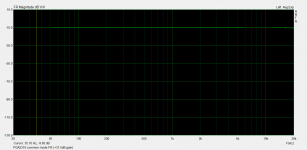 pga2310 common mode frequency response 31.5dB.png52.4 KB · Views: 154
pga2310 common mode frequency response 31.5dB.png52.4 KB · Views: 154 -
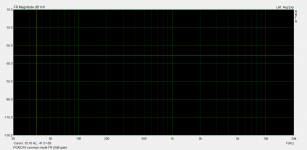 pga2310 common mode frequency response 0dB.png52.2 KB · Views: 150
pga2310 common mode frequency response 0dB.png52.2 KB · Views: 150 -
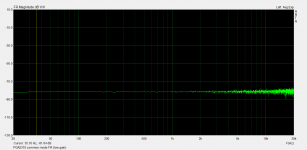 pga2310 common mode frequency response less than 0dB.png56.4 KB · Views: 620
pga2310 common mode frequency response less than 0dB.png56.4 KB · Views: 620 -
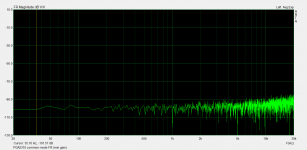 pga2310 common mode frequency response min gain.png70.3 KB · Views: 610
pga2310 common mode frequency response min gain.png70.3 KB · Views: 610 -
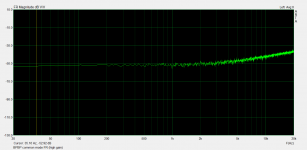 BPBP common mode frequency response high gain.png57.5 KB · Views: 630
BPBP common mode frequency response high gain.png57.5 KB · Views: 630 -
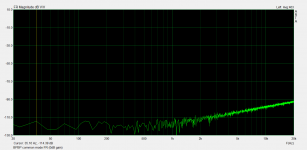 BPBP common mode frequency response 0dB gain.png60.9 KB · Views: 628
BPBP common mode frequency response 0dB gain.png60.9 KB · Views: 628 -
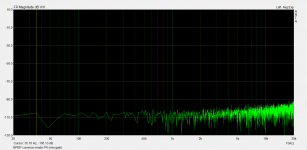 BPBP common mode frequency response min gain.png71.8 KB · Views: 654
BPBP common mode frequency response min gain.png71.8 KB · Views: 654 -
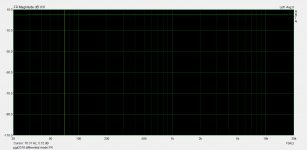 pga2310 differential mode frequency response.png51.4 KB · Views: 163
pga2310 differential mode frequency response.png51.4 KB · Views: 163
Last edited:
O.k., thanks for doing all the work so rapidly.I agree - the whole point of this exercise for me is not to try yet another schematic but to learn how to make low distortion PCBs. Mr. Putzeys' method works here and also for gainclones/chipamps.
See attached. Not quite apple-to-apple, as resistor tolerances in my BPBP are better than in the through-hole board, but still interesting.
- The first three graphs are from my BPBP on Linear Audio's PCB with 0.1% resistors, at different gains: min gain, ~0dB (pot at 12 o'clock) and close to max (~3 o'clock).
- The next four are my PGA2310 board with 1% resistors (limiting CMRR to about -50dB), also at several gains: mute, some low gain between mute and 0dB, 0dB, and max (+31.5dB).
- The last one is my board at 0dB in the normal differential mode, to set the level benchmark.
Hans
Tinkered with it, at power off it turns to maximum attenuation, fail safe if you like. Phew. Obe less thing to worry about.
Did you test, fully connected up? Phew!
I am not sure this is the right place to ask for help. I have bought a Maya controller With OLED+BLE+power relay board and volCB from Hans Polak.
The Maya unit starts up fine and can be controlled by an Apple remote, but the volCB board id not responding. When I put a scope on the SCL and SDA, regardless if the volCB is connected or not, thy are both @ +5V and stays there even though the displays say the volume is going up/down or changing input aso...
The bluetooth will not mate with my Android phone. The phone can see the Maya unit, but say there is an error in mating with it.
When I try to select number of inputs, with the select buttom and rotary encoder, I cannot change it from 6 channels. If I use the remote , I can change the number , but I cannot save it...
Please help, it is sort of a boat-anchor for me right now
The Maya unit starts up fine and can be controlled by an Apple remote, but the volCB board id not responding. When I put a scope on the SCL and SDA, regardless if the volCB is connected or not, thy are both @ +5V and stays there even though the displays say the volume is going up/down or changing input aso...
The bluetooth will not mate with my Android phone. The phone can see the Maya unit, but say there is an error in mating with it.
When I try to select number of inputs, with the select buttom and rotary encoder, I cannot change it from 6 channels. If I use the remote , I can change the number , but I cannot save it...
Please help, it is sort of a boat-anchor for me right now
Koldby,
Please let me know your Maya BPBP firmware version.
At power on, I2C bus will try to get any device with address in range 1..6, if not found will remain idle. Please chech your VoICB board.
To connect to an BLE enabled device you need to enable bluetooth on your phone/tablet and to open Maya application and connect from inside Maya application, not phone global system settings.
I do not have a Maya BPBP right now, but as far I remember after you change the number if inputs you need to press power and than exit from settings. Dan will test this for you later today.
Hope this helps.
Regards,
Tibi
Please let me know your Maya BPBP firmware version.
At power on, I2C bus will try to get any device with address in range 1..6, if not found will remain idle. Please chech your VoICB board.
To connect to an BLE enabled device you need to enable bluetooth on your phone/tablet and to open Maya application and connect from inside Maya application, not phone global system settings.
I do not have a Maya BPBP right now, but as far I remember after you change the number if inputs you need to press power and than exit from settings. Dan will test this for you later today.
Hope this helps.
Regards,
Tibi
Last edited by a moderator:
Koldby,
Please let me know your Maya BPBP firmware version.
At power on, I2C bus will try to get any device with address in range 1..6, if not found will remain idle. Please chech your VoICB board.
To connect to an BLE enabled device you need to enable bluetooth on your phone/tablet and to open Maya application and connect from inside Maya application, not phone global system settings.
I do not have a Maya BPBP right now, but as far I remember after you change the number if inputs you need to press power and than exit from settings. Dan will test this for you later today.
Hope this helps.
Regards,
Tibi
The display says: maya_1_6_oled-bp.
I have checked and rec checked and checked again the volCB board, but I cannot find anything wrong. It gets the 5 volt on the two PCF85741.
What could be wrong? Is the PCF85741 of some reason defective?
Got the Bluetooth working , thanks, and the channel numbers are now correct. Is there anywhere a users manual to Maya? or do I have to read all the threads to get the information?
- Home
- Source & Line
- Analog Line Level
- BPPBP - Bruno Putzey's Purist Balanced Preamp (well a balanced volume control really)
